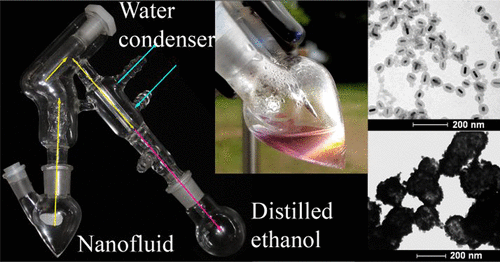当前位置:
X-MOL 学术
›
J. Phys. Chem. C
›
论文详情
Our official English website, www.x-mol.net, welcomes your feedback! (Note: you will need to create a separate account there.)
Improving the Performance of Direct Solar Collectors and Stills by Controlling the Morphology and Size of Plasmonic Core–Shell Nanoheaters
The Journal of Physical Chemistry C ( IF 3.7 ) Pub Date : 2021-09-01 , DOI: 10.1021/acs.jpcc.1c05952 Aline M. Vieira 1 , Nathália Talita C. Oliveira 2 , Kerolly T. P. B. Silva 3 , Albert S. Reyna 1, 3
The Journal of Physical Chemistry C ( IF 3.7 ) Pub Date : 2021-09-01 , DOI: 10.1021/acs.jpcc.1c05952 Aline M. Vieira 1 , Nathália Talita C. Oliveira 2 , Kerolly T. P. B. Silva 3 , Albert S. Reyna 1, 3
Affiliation

|
Plasmonic nanofluids, based on metal nanoparticles (NPs), has received tremendous attention for its potential to increase the efficiency of solar energy harvesting and harnessing systems. The ability to manage their optical absorption by tuning localized surface plasmon (LSP) bands is the reason why metal NPs are considered excellent nanoheaters with unique thermo-optic properties. In this work, we demostrate the influence of the tuning of plasmonic nanofluid absorption bands in different spectral regions, by modifying the morphology and size of the core–shell NPs, on the efficiency of plasmonic nanoheaters to heat fluids and generate steam. Five plasmonic nanofluids containing spherical Au@SiO2, rodlike Au@SiO2, with three different aspect ratios, and spherical SiO2@Au nanoshells were fabricated and characterized to study the local heating induced by plasmon-enhanced light absorption. Gains of up to 28.3 times in the nanofluid temperature increase in direct absorption solar collectors (DASCs) and 7.5 times in the amount of steam generated in the solar ethanol distillation were measured from control over LSP resonances of spherical and rodlike core–shell NPs. Energy distribution analysis shows that plasmonic nanofluids present an efficient energy transfer management, dedicating ∼72% of the absorbed energy to heating liquids at low levels of solar irradiance. However, at high solar irradiances, the good spectral matching between the plasmonic nanofluid LSP bands and the solar irradiance spectrum promotes strong local heating around the core–shell NPs, allowing local temperatures above the boiling point to be reached. Under these conditions, plasmonic nanofluids spend a small amount of energy to heat liquids and they transfer ∼83% of the absorbed energy to generate steam. Thus, a 7.7-fold increase in solar ethanol vaporization rate was achieved. The experimental results, understood from the optical properties of core–shell plasmonic NPs by using the Maxwell–Garnett theoretical model, corroborate the importance of fabricating nanoheaters with projected geometries to maximize the efficiency of solar collectors and stills.
中文翻译:

通过控制等离子体核壳纳米加热器的形态和尺寸来提高直接太阳能收集器和蒸馏器的性能
基于金属纳米粒子 (NPs) 的等离子纳米流体因其在提高太阳能收集和利用系统效率方面的潜力而受到极大关注。通过调整局部表面等离子体 (LSP) 带来管理其光吸收的能力是金属 NP 被认为是具有独特热光特性的优秀纳米加热器的原因。在这项工作中,我们通过修改核壳纳米粒子的形态和尺寸,证明了在不同光谱区域调整等离子体纳米流体吸收带对等离子体纳米加热器加热流体和产生蒸汽的效率的影响。五种等离子体纳米流体包含球形Au@SiO 2,棒状Au@SiO 2,具有三种不同的纵横比,以及球形SiO 2@Au 纳米壳被制造并表征以研究由等离子体增强的光吸收引起的局部加热。通过控制球形和棒状核壳 NP 的 LSP 共振,测量到直接吸收太阳能集热器 (DASC) 中纳米流体温度增加高达 28.3 倍,太阳能乙醇蒸馏中产生的蒸汽量增加 7.5 倍。能量分布分析表明,等离子体纳米流体具有有效的能量转移管理,可将约 72% 的吸收能量用于在低水平太阳辐照度下加热液体。然而,在高太阳辐照度下,等离子体纳米流体 LSP 带和太阳辐照光谱之间的良好光谱匹配促进了核壳 NPs 周围的强烈局部加热,允许达到高于沸点的局部温度。在这些条件下,等离子体纳米流体消耗少量能量来加热液体,并且它们转移约 83% 的吸收能量以产生蒸汽。因此,太阳能乙醇蒸发率提高了 7.7 倍。通过使用 Maxwell-Garnett 理论模型从核壳等离子体 NPs 的光学特性中理解的实验结果证实了制造具有投影几何形状的纳米加热器以最大化太阳能收集器和蒸馏器的效率的重要性。
更新日期:2021-09-16
中文翻译:

通过控制等离子体核壳纳米加热器的形态和尺寸来提高直接太阳能收集器和蒸馏器的性能
基于金属纳米粒子 (NPs) 的等离子纳米流体因其在提高太阳能收集和利用系统效率方面的潜力而受到极大关注。通过调整局部表面等离子体 (LSP) 带来管理其光吸收的能力是金属 NP 被认为是具有独特热光特性的优秀纳米加热器的原因。在这项工作中,我们通过修改核壳纳米粒子的形态和尺寸,证明了在不同光谱区域调整等离子体纳米流体吸收带对等离子体纳米加热器加热流体和产生蒸汽的效率的影响。五种等离子体纳米流体包含球形Au@SiO 2,棒状Au@SiO 2,具有三种不同的纵横比,以及球形SiO 2@Au 纳米壳被制造并表征以研究由等离子体增强的光吸收引起的局部加热。通过控制球形和棒状核壳 NP 的 LSP 共振,测量到直接吸收太阳能集热器 (DASC) 中纳米流体温度增加高达 28.3 倍,太阳能乙醇蒸馏中产生的蒸汽量增加 7.5 倍。能量分布分析表明,等离子体纳米流体具有有效的能量转移管理,可将约 72% 的吸收能量用于在低水平太阳辐照度下加热液体。然而,在高太阳辐照度下,等离子体纳米流体 LSP 带和太阳辐照光谱之间的良好光谱匹配促进了核壳 NPs 周围的强烈局部加热,允许达到高于沸点的局部温度。在这些条件下,等离子体纳米流体消耗少量能量来加热液体,并且它们转移约 83% 的吸收能量以产生蒸汽。因此,太阳能乙醇蒸发率提高了 7.7 倍。通过使用 Maxwell-Garnett 理论模型从核壳等离子体 NPs 的光学特性中理解的实验结果证实了制造具有投影几何形状的纳米加热器以最大化太阳能收集器和蒸馏器的效率的重要性。



























 京公网安备 11010802027423号
京公网安备 11010802027423号